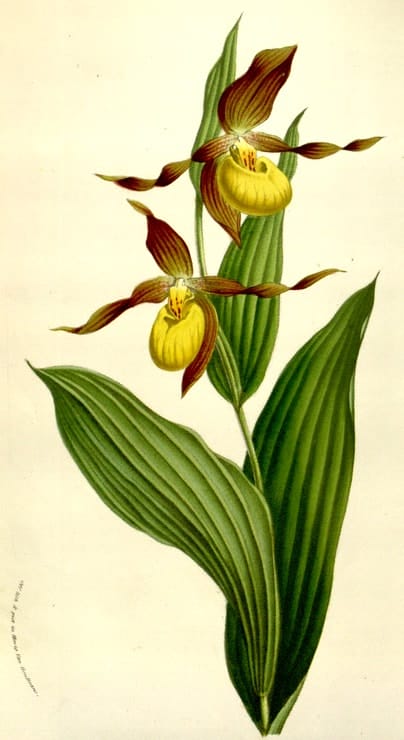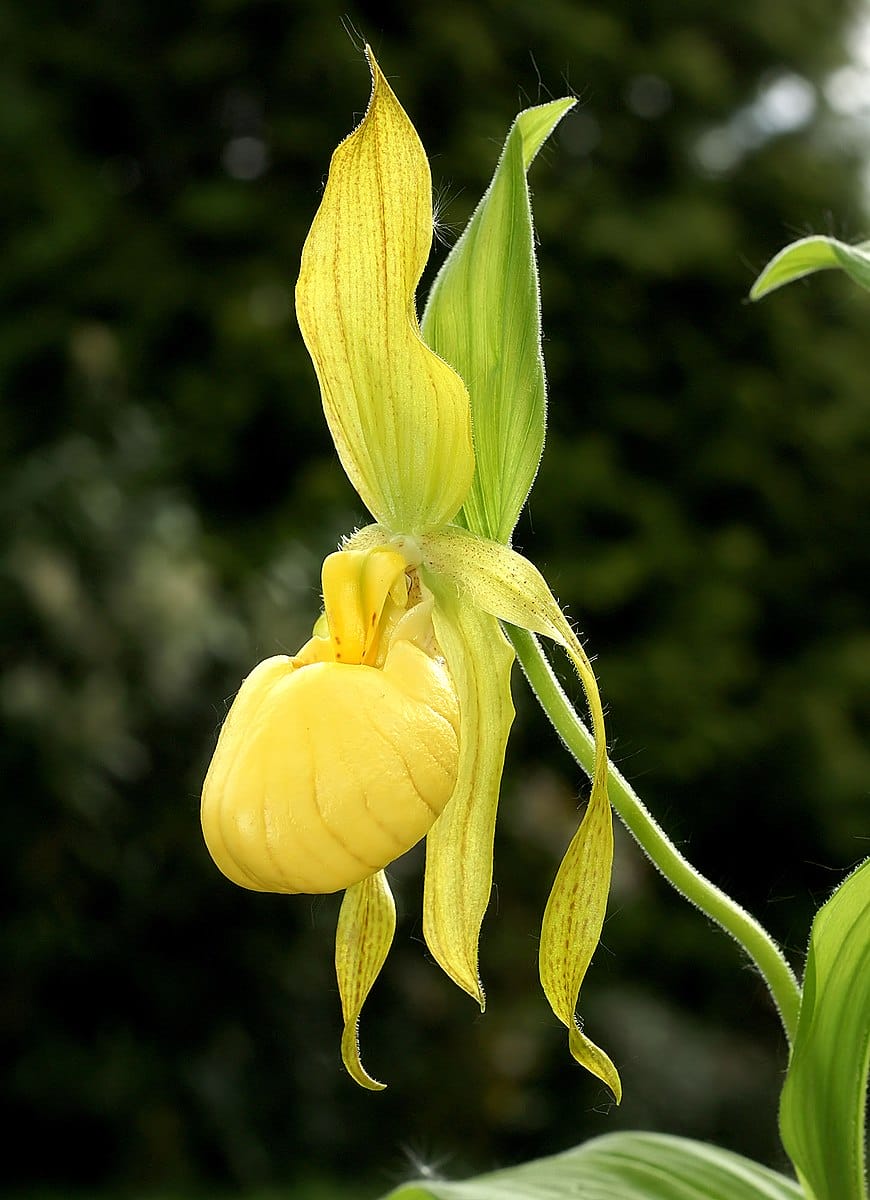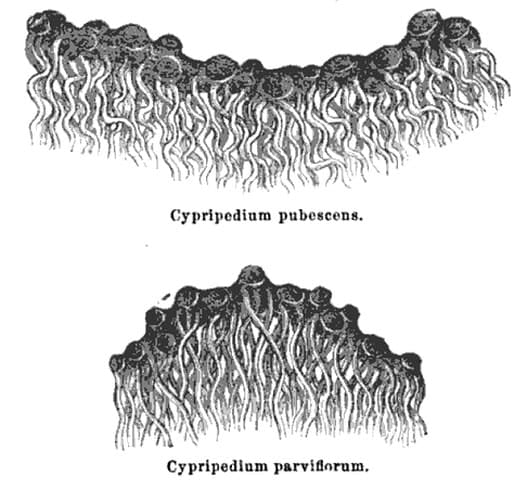Cypripedium, Ladies SlipperAmerican Valerian, Yellow Ladies Slipper |

|
 Cypripedium pubescens
Cypripedium pubescensVan Houtte, Flore des serres et des jardin de l’Europe, vol. 10 (1855)
 Cypripedium parviflorum var. pubescens
Cypripedium parviflorum var. pubescens(Photo by Orchi) (Wikimedia)
 Root of Cypripedium species: Top C. pubescens; Bottom: C. parviflorum
Root of Cypripedium species: Top C. pubescens; Bottom: C. parviflorumBotanical name:
Cypripedium spp.
Two main species are used:
- C. parviflorum
- C. parviflorum var. pubescens (syn. C. pubescens)
Parts used:
Root
Temperature & Taste:
Warm, dry. Sweet, Bitter, Pungent
Uses:
1. Settles Wind, Stops Spasms:
-Spasms, Convulsions, Epilepsy
-Hysteria
-also used for acute Wind conditions, acute Headache, body aches etc.
2. Moves the Qi, Calms the Nerves, Eases Pain:
-‘producing a more calm and cheerful condition of body and mind’. (King’s)
-Neuralgia
-the pain of Rheumatism
-Nervousness, Insomnia
3. Moves the Blood:
-Amenorrhea, Dysmenorrhea
-promotes or enhances Labor;
-After pains
Dose:
Powder: 500–1500mg
Infusion: half oz. in a pint of boiling water; infuse for half hour. Dose: half–2 fluid ounces
Tincture: 1–3 fluid drams
Substitute:
1. Valerian
2. It may be used wherever Scullcap is indicated.
3. Uvularia perfoliata (King’s)
Comment:
‘Although considered by many practitioners superior to the foreign Valerian, yet it will be found inefiicient in many instances where the European article will prove beneficial’. (King’s)
Main Combinations:
1. Spasms, Convulsions:
i. Cypripedium, Lobelia, Capsicum, form a Tincture with Compound Tincture of Myrrh. (Cook)
2. Nerve disorders:
i. Cypripedium, Camomile
ii. Cypripedium, Black Cohosh, Scullcap (Cook)
iii. nervous excitability, insomnia, restlessness, Cypripedium, Scullcap (King)
3. Neuralgia, Cypripedium; Scullcap, Xanthoxylum, Asclepias tuberosa, Lobelia, Aniseed
4. Hysteria, Cypripedium with Asafetida
5. Dysmenorrhea, Cyperipedium, Blue Cohosh, Camomile, Ginger (Cook)
6. To promote Labor:
i. Cypripedium, Raspberry leaf
ii. Cypripedium, Blue Cohosh
iii. Cypripedium, Blue Cohosh, Virginian Snakeroot (Aristolchia)
iv. Cypripedium, Blue Cohosh, Trillium, Myrica
7. After Pains, Cypripedium, Trillium
8. Rheumatism, Cypripedium with Phytolacca berries
Major Formulas:
Cautions:
Avoid during Pregnancy
Main Preparations used:
Tincture:, Fluid Extract, Cypripedin
1. Fluid Extract:
‘Macerate a pound of crushed roots in 70 percent alcohol; transfer to a percolator, and treat with alcohol of the same strength till eight fluid ounces have passed. Set this aside, continue the process with water till exhausted, evaporate the last product on a water bath to eight fluid ounces, and mix the two liquors. This is a good preparation, of which the dose may range from five to twenty drops’. (Cook, The Physio-Medical Dispensatory)
2. Cypripedin (an Extract):
‘Macerate the crushed roots with absolute alcohol; transfer to a percolator, and treat with absolute alcohol till exhausted; distill off four-fifths of the alcohol at a low temperature, and evaporate the remainder on a. low water bath till of the consistence of thick molasses; wash this product in 70 percent alcohol, and filter through muslin; by which step the extractive matter is washed away, and the cypripedin retained upon the filter. Now evaporate carefully; and when thoroughly dry, reduce to a powder in a mortar moderately warm. If the first product be not washed so as to remove the extractive matter, the cypripedin will be a brownish powder that will slowly settle into a gummy mass. The washed product is a dull-yellowish powder, and represents the plant quite well. As the roots of cypripedium vary greatly in strength, according to season, soil, and method of drying, so this alcoholic extract cypripedin is not always of the same strength, though nearly so. Dose, one to three grains, at such intervals as necessity requires’, (Cook, The Physio-Medical Dispensatory)
